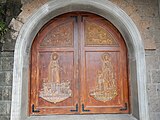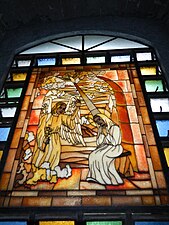Immaculate Conception Parish Church (Dasmariñas)
| Dasmariñas Church | |
|---|---|
| Immaculate Conception Parish Church | |
Parokya ng La Inmaculada Concepcion(Filipino) | |
 Churchfacadein 2013 | |
Location inLuzon | |
| 14°19′37″N120°56′10″E/ 14.3270°N 120.9360°E | |
| Location | Dasmariñas,Cavite |
| Country | Philippines |
| Denomination | Roman Catholic |
| History | |
| Status | Church building |
| Founded | October 21, 1866 |
| Founder(s) | Augustinian Recollects |
| Dedication | Immaculate Conception |
| Dedicated | 1867 |
| Events | Battle of Perez Dasmariñas |
| Architecture | |
| Functional status | Active, Under renovation |
| Heritage designation | Marked Historical Structure of the Philippines |
| Designated | 1986 |
| Architectural type | Church building |
| Style | NeoclassicalBaroque |
| Groundbreaking | 1867 |
| Specifications | |
| Length | 180 feet (55 m) |
| Width | 80 feet (24 m) |
| Navewidth | 52 feet (16 m) |
| Number ofdomes | None |
| Number oftowers | 2 |
| Materials | Stone, bricks and wood |
| Administration | |
| Province | Ecclesiastical Province of Manila |
| Archdiocese | Roman Catholic Archdiocese of Manila |
| Diocese | Roman Catholic Diocese of Imus |
| Clergy | |
| Priest in charge | Orlando Santos |
| Priest(s) | Orlando Santos |
| Assistant priest(s) | Dennis Dueñas |
TheImmaculate Conception Parish Church,also known asDasmariñas Church,is the firstRoman Catholicparish churchin the city ofDasmariñas,province ofCavite,Philippines.It is under the jurisdiction of theDiocese of Imus.The stone church was constructed right after the establishment of Dasmariñas as a separate parish in 1866. The church andconventwas the site of bloodshed during theBattle of Perez Dasmariñas of thePhilippine revolutionagainst Spain. It was declared as an important historical structure by the National Historical Institute (nowNational Historical Commission of the Philippines) with the placing of a historical marker in 1986.
On December 7, 2002, the Venerated and Miraculous Image of the Patroness of the City of Dasmariñas—the Lady of Immaculate Conception—was Episcopally Crowned by the Bishop Emeritus of Imus Most Rev. Manuel Sobreviñas D.D.; the next day, on the Occasion of The Solemnity of the Immaculate Conception, the Parish Church was Dedicated to God by then Bishop of Imus Most Rev.Luis Antonio G. TagleSthD. It celebrated its 150th Jubilee Year on July 5, 2017.
History
[edit]
Theparishof Dasmariñas, then known as Perez-Dasmariñas, started as a chapel of parish ofImus,its former mother town, during theSpanish colonial period.Perez-Dasmariñas then was a barrio and part of theHacienda de Imus(Imus Estate) owned and administered by theAugustinian Recollects.After the establishment of Perez-Dasmariñas as a politically separate town on May 12, 1864, a petition was sent to Madrid by the Recollects for the creation of a newparishfor the sake of the people of a growing town and for their own interests. Hence, on October 21, 1866, Her Most Catholic MajestyQueen Isabella IIsigned the Royal Order creating the new parish of Perez-Dasmariñas. The Royal Order states:
- "Her Majesty, the Queen, conceded to approve by a Royal Order last October 21, 1866, the erection of a new parish in the new town of Perez-Dasmariñas, independent from Imus, its origin, in the province of Cavite. With previous instructions from the proceedings where the interested parties were and for reason of convenience and need that the said town should constitute an independent parish...with the use of all corresponding authority because of its sacredness and furthermore, in accordance with the Council of Trent, Chapter IV Section XXIV about Reformation which is in accord with Law No. XXX first book onRecopilacion de las Indias,we have established jurisdiction separate from Imus, her origin. The limits of this new parish shall be Religious Order of the Augustinian Recollect Fathers. "[1]
However, Royal Orders took some time before it reached the Islands and its actual implementation did not start till the following year, 1867. The new parish of Perez-Dasmariñas was placed under thepatronageof theVirgin MaryasOur Lady of the Immaculate Conceptionwith theArchbishop of Manilaand the Recollect Prior Provincial as its main proponents. The same year, Recollect priest Valentin Diaz was installed as the first parish priest of Perez-Dasmariñas.
Construction of the church
[edit]The stone church of Perez-Dasmariñas was built with the establishment of the parish. Don Esperidion Arevalo ofSanta Cruz, Manila,a famous sculptor, was commissioned by theRecollect Provincialto carve the image ofLa Purisima Concepcion(Immaculate Conception) in 1867. Arevalo was the same artist who made the classical type ofretabloofChurch of Imusin 1851.[1]
Very little information are available regarding the architectural design of the church. Old photographs taken towards the end of the Spanish rule showed that the church had a very simple facade without a belfry. The convent is nicely built with a spacious veranda. The parish ofMaragondonlent the sum of $1,000 (Mexican) for the repairs and renovation of the church of Perez-Dasmariñas in 1874.[2]Later in 1880, San Francisco de Malabon (now General Trias) lent $500 (Mexican) to Perez-Dasmariñas for the same purpose.[1]
- Church exterior features
-
One of the bell towers of the church
-
One of the front doors of the church
-
ChurchNHIhistorical marker installed in 1986
The present church has aneoclassicaldesign with aporticocovering the front door of the church. Thefacadeis flanked on both sides by bell towers, each four-story tall. The parish church had two old bells. One was acquired upon the erection of the parish. This bell, which is small, has the inscription "Perez Dasmariñas año 1867 approx. 14 libras".The second one was donated by the localprincipalias(upper class) of the town. It was founded in 1890 by the famousFundicion de Hilario Sunico(Hilario Sunico Foundry) in Manila.[1]The side walls of the structure are flanked by thick buttresses to strengthen the walls from earthquakes.
A school was also established by the Recollects next to the church. The children of Perez-Dasmariñas were taught the basic tenets of the Christian faith and the basic knowledge of counting, reading and writing by the friars. They were required to train and pay good teachers and ensure that basic necessities for teaching purposes were provided. Later, the school was subsidized by the local fund of the town.[1]
The church underwent constant renovations through the years, altering much of the church's original design. At present, the church is undergoing another major renovation which involves the raising of its ceiling.
Early curate of the church
[edit]The first parish priest of Perez-Dasmariñas, Valentin Diaz, was born on November 3, 1837, inRincon de Soto,Logroño,Spain and was ordained in November 1860. This young missionary was immediately sent to the Philippines and one of his first assignments was Perez-Dasmariñas. He died in Manila on November 20, 1877.[1]
- Interior of the Immaculate Conception Parish Church
-
Theretabloand main altar
-
Stained glasswindow of the church
-
Other religious relics of the church
Pedro Mollar succeeded Diaz. He was born inHuesca,Spain, on April 5, 1838, and was assigned as missionary to various parts of the Philippines before he became the parish priest of Perez-Dasmariñas. He died in 1886 while he was at Suez Canal on his way back to Spain.[1]
Candido Puerta of Villanueva de la Torre,Guadalajara, Spaincame to the town without parish assignment but just to learn theTagalog language.However, he later became the parish priest from 1887 to 1894. Toribio Mateo ofCorella,Navarre,Spain. He was born on April 16, 1846. He too was assigned in various missions before and after his assignment in Perez-Dasmariñas. He had two separate terms as parish priest. He was the parish priest during the outbreak of the revolution and was killed by the revolutionaries in September 1896.[1]
With the death of Toribio Mateo in 1896, Perez-Dasmariñas lost its resident parish priest. Victor Oscoz, the parish priest of Imus simultaneously administered the parish of the town. After thePhilippine revolution,the parish was given to the Filipino secular clergy.[1]
Spanish Revolution
[edit]During thePhilippine Revolution,gobernadorcillo Don Placido Campos and his secretary Francisco Barzaga lead the uprising against the Spaniards which eventually freed their town in 1896. The Spaniards tried to recapture the town of Perez Dasmariñas from the revolutionaries. On February 25, 1897, Filipino revolutionaries took refuge in the convent that was later set on fire by the Spaniards.[3]These men were shot as they emerged from the church. Others had shut themselves up in the church. With the church surrounded, the mountain artillery was brought out into position and from a distance of 35 metres (115 ft), the strong doors of the church were bombarded and the troops went in through the breach. Many lost their lives in the sanctuary. The event was known as theBattle of Perez Dasmariñas.[1]During that bloody battle, the Spaniards burned all structures in the town proper except the Catholic Church which was later used as a garrison.[4]
Japanese Occupation
[edit]After a similar event in the church of Imus a day before, several men of the town who were also suspected of being members of guerrilla forces were detained by Japanese soldiers inside the church on December 17, 1944. Many residents were killed or executed during the Japanese occupation.[5]
References
[edit]- ^abcdefghij"The History of Dasmariñas: Spanish Colonization"
- ^Jose, Regalado Trota Jr. (1986)."Church Expenses in Nineteenth Century Cavite".Philippine Studies.34(3): 360–373.RetrievedSeptember 4,2014– viaJSTOR.
- ^"History of Dasmarinas, Cavite".RetrievedSeptember 3,2014.
- ^"History".Official Website of Dasmariñas City.Archived fromthe originalon October 12, 2014.RetrievedSeptember 3,2014.
- ^"Churches in Cavite".March 24, 2010.RetrievedSeptember 4,2014.
External links
[edit] Media related toImmaculate Conception Parish Church of Dasmariñasat Wikimedia Commons
Media related toImmaculate Conception Parish Church of Dasmariñasat Wikimedia Commons- Immaculate Conception Parish ChurchonFacebook
- Roman Catholic churches in Cavite
- Buildings and structures in Dasmariñas
- Roman Catholic churches completed in 1867
- 1867 establishments in the Philippines
- Marked Historical Structures of the Philippines
- Spanish Colonial architecture in the Philippines
- Baroque church buildings in the Philippines
- 19th-century Roman Catholic church buildings in the Philippines
- Neoclassical church buildings in the Philippines
- Churches in the Roman Catholic Diocese of Imus










